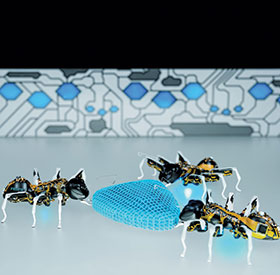

Drawing inspiration from the delicate anatomy of the ant, Festo has transferred their cooperative behaviour to the world of technology using complex control algorithms. Like their natural role models, the BionicANTs work together under clear rules. They communicate with each other and coordinate their actions and movements among each other. Each ant makes its decisions autonomously, but in doing so is always subordinate to the common objective and thereby plays its part towards solving the task in hand. Thanks to this intelligent division of work, they are able to transport loads efficiently that a single ant could not move. The artificial ants thus demonstrate how autonomous individual components can solve a complex task together working as an overall networked system.
Unique production technologies
Not only the cooperative behaviour of the artificial ants is amazing. Even their production method is unique. The laser-sintered components are embellished with visible conductor structures using 3D moulded interconnect device (MID) technology. The electrical circuits are attached on the surface of the components, which thereby take on design and electrical functions at the same time. In this way, all the technical components can be fitted into or onto the ant’s body and be exactly coordinated with each other. After being put into operation, an external control system is no longer required. It is possible, however, to monitor all the parameters wirelessly and to make a regulating intervention.
The BionicANTs also come very close to their natural role model in terms of design and constructional layout. Even the mouth instrument used for gripping objects is replicated in very accurate detail. The pincer movement is provided by two piezo-ceramic bending transducers, which are built into the jaw as actuators. If a voltage is applied to the tiny plates, they deflect and pass on the direction of movement mechanically to the gripping jaws.
New application of piezo technology
Festo also makes use of the benefits of piezo technology for the actuator technology used on the legs of the artificial ants. The bending actuators can be controlled very precisely and quickly. They require little energy, are almost wear-resistant and do not need much space. Three trimorphic piezo-ceramic bending transducers, which serve both as an actuator and a design element, are therefore fitted into each thigh. By deflecting the top bending transducer, the ant lifts its leg. With the pair underneath, each leg can be exactly deflected forwards and backwards. To increase the relatively low lift, the team developed a flexible hinge joint, which extends the ant’s step size significantly.
Highly complex control algorithms
With two rechargeable batteries on board, the ants can work for 40 minutes before they have to link up with a charging station via their feelers. All actions are based on a distributed set of rules, which have been worked out in advance using mathematical modelling and simulations and are stored on every ant. The control strategy provides for a multi-agent system in which the participants are not hierarchically ordered. Instead, all the BionicANTs contribute to the process of finding a solution together by means of distributed intelligence. The information exchange between the ants required for this takes place via the radio module located in the torso.
Camera system works with floor sensor
The ants use the 3D stereo camera in their head to identify the gripping object as well as for self-localisation purposes. With its help, each ant is able to contextualise itself in its environment using landmarks.
The opto-electrical sensor in the abdomen uses the floor structure to tell how the ant is moving in relation to the ground. With both systems combined, each ant knows its position – even if its sight is temporarily impaired.
Production of the future
This cooperative behaviour provides interesting approaches for the factory of tomorrow. Future production systems will be founded on intelligent components, which adjust themselves flexibly to different production scenarios and thus take on tasks from a higher control level.
For more information contact Kershia Beharie, Festo, 086 003 3786, kershia.beharie@festo.com, www.festo.co.za
| Tel: | 08600 FESTO (33786) |
| Fax: | +27 11 974 2157 |
| Email: | sales.za@festo.com |
| www: | www.festo.co.za |
| Articles: | More information and articles about Festo |
© Technews Publishing (Pty) Ltd | All Rights Reserved